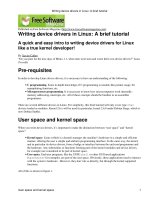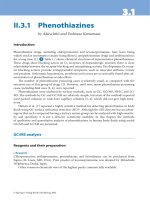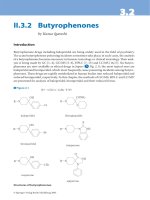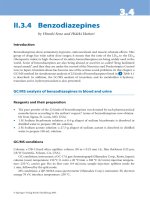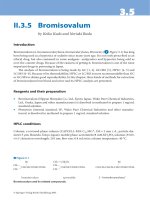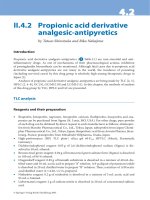Tài liệu Writing device drivers in Linux: A brief tutorial docx
Bạn đang xem bản rút gọn của tài liệu. Xem và tải ngay bản đầy đủ của tài liệu tại đây (1.02 MB, 21 trang )
Published on Free Software Magazine ()
Writing device drivers in Linux: A brief tutorial
A quick and easy intro to writing device drivers for Linux
like a true kernel developer!
By Xavier Calbet
“Do you pine for the nice days of Minix-1.1, when men were men and wrote their own device drivers?” Linus
Torvalds
Pre-requisites
In order to develop Linux device drivers, it is necessary to have an understanding of the following:
C programming. Some in-depth knowledge of C programming is needed, like pointer usage, bit
manipulating functions, etc.
•
Microprocessor programming. It is necessary to know how microcomputers work internally:
memory addressing, interrupts, etc. All of these concepts should be familiar to an assembler
programmer.
•
There are several different devices in Linux. For simplicity, this brief tutorial will only cover type char
devices loaded as modules. Kernel 2.6.x will be used (in particular, kernel 2.6.8 under Debian Sarge, which is
now Debian Stable).
User space and kernel space
When you write device drivers, it’s important to make the distinction between “user space” and “kernel
space”.
Kernel space. Linux (which is a kernel) manages the machine’s hardware in a simple and efficient
manner, offering the user a simple and uniform programming interface. In the same way, the kernel,
and in particular its device drivers, form a bridge or interface between the end-user/programmer and
the hardware. Any subroutines or functions forming part of the kernel (modules and device drivers,
for example) are considered to be part of kernel space.
•
User space. End-user programs, like the UNIX shell or other GUI based applications
(kpresenter for example), are part of the user space. Obviously, these applications need to interact
with the system’s hardware . However, they don’t do so directly, but through the kernel supported
functions.
•
All of this is shown in figure 1.
Writing device drivers in Linux: A brief tutorial
User space and kernel space 1
Figure 1: User space where applications reside, and kernel space where modules or device drivers reside
Interfacing functions between user space and
kernel space
The kernel offers several subroutines or functions in user space, which allow the end-user application
programmer to interact with the hardware. Usually, in UNIX or Linux systems, this dialogue is performed
through functions or subroutines in order to read and write files. The reason for this is that in Unix devices are
seen, from the point of view of the user, as files.
On the other hand, in kernel space Linux also offers several functions or subroutines to perform the low level
interactions directly with the hardware, and allow the transfer of information from kernel to user space.
Usually, for each function in user space (allowing the use of devices or files), there exists an equivalent in
kernel space (allowing the transfer of information from the kernel to the user and vice-versa). This is shown in
Table 1, which is, at this point, empty. It will be filled when the different device drivers concepts are
introduced.
Events User functions Kernel functions
Load module
Open device
Read device
Write device
Close device
Remove module
Table 1. Device driver events and their associated interfacing functions in kernel space and user space.
Interfacing functions between kernel space and the
hardware device
There are also functions in kernel space which control the device or exchange information between the kernel
and the hardware. Table 2 illustrates these concepts. This table will also be filled as the concepts are
introduced.
Writing device drivers in Linux: A brief tutorial
Interfacing functions between kernel space and the hardware device 2
Events Kernel functions
Read data
Write data
Table 2. Device driver events and their associated functions between kernel space and the hardware
device.
The first driver: loading and removing the driver in
user space
I’ll now show you how to develop your first Linux device driver, which will be introduced in the kernel as a
module.
For this purpose I’ll write the following program in a file named nothing.c
<nothing.c> =
#include <linux/module.h>
MODULE_LICENSE("Dual BSD/GPL");
Since the release of kernel version 2.6.x, compiling modules has become slightly more complicated. First, you
need to have a complete, compiled kernel source-code-tree. If you have a Debian Sarge system, you can
follow the steps in Appendix B (towards the end of this article). In the following, I’ll assume that a kernel
version 2.6.8 is being used.
Next, you need to generate a makefile. The makefile for this example, which should be named Makefile,
will be:
<Makefile1> =
obj-m := nothing.o
Unlike with previous versions of the kernel, it’s now also necessary to compile the module using the same
kernel that you’re going to load and use the module with. To compile it, you can type:
$ make -C /usr/src/kernel-source-2.6.8 M=pwd modules
This extremely simple module belongs to kernel space and will form part of it once it’s loaded.
In user space, you can load the module as root by typing the following into the command line:
# insmod nothing.ko
The insmod command allows the installation of the module in the kernel. However, this particular module
isn’t of much use.
It is possible to check that the module has been installed correctly by looking at all installed modules:
# lsmod
Writing device drivers in Linux: A brief tutorial
The first driver: loading and removing the driver in user space 3
Finally, the module can be removed from the kernel using the command:
# rmmod nothing
By issuing the lsmod command again, you can verify that the module is no longer in the kernel.
The summary of all this is shown in Table 3.
Events User functions Kernel functions
Load module insmod
Open device
Read device
Write device
Close device
Remove module rmmod
Table 3. Device driver events and their associated interfacing functions between kernel space and user
space.
The “Hello world” driver: loading and removing the
driver in kernel space
When a module device driver is loaded into the kernel, some preliminary tasks are usually performed like
resetting the device, reserving RAM, reserving interrupts, and reserving input/output ports, etc.
These tasks are performed, in kernel space, by two functions which need to be present (and explicitly
declared): module_init and module_exit; they correspond to the user space commands insmod and
rmmod , which are used when installing or removing a module. To sum up, the user commands insmod and
rmmod use the kernel space functions module_init and module_exit.
Let’s see a practical example with the classic program Hello world:
<hello.c> =
#include <linux/init.h>
#include <linux/module.h>
#include <linux/kernel.h>
MODULE_LICENSE("Dual BSD/GPL");
static int hello_init(void) {
printk("<1> Hello world!\n");
return 0;
}
static void hello_exit(void) {
printk("<1> Bye, cruel world\n");
}
module_init(hello_init);
module_exit(hello_exit);
Writing device drivers in Linux: A brief tutorial
The “Hello world” driver: loading and removing the driver in kernel space 4
The actual functions hello_init and hello_exit can be given any name desired. However, in order for
them to be identified as the corresponding loading and removing functions, they have to be passed as
parameters to the functions module_init and module_exit.
The printk function has also been introduced. It is very similar to the well known printf apart from the
fact that it only works inside the kernel. The <1> symbol shows the high priority of the message (low
number). In this way, besides getting the message in the kernel system log files, you should also receive this
message in the system console.
This module can be compiled using the same command as before, after adding its name into the Makefile.
<Makefile2> =
obj-m := nothing.o hello.o
In the rest of the article, I have left the Makefiles as an exercise for the reader. A complete Makefile that will
compile all of the modules of this tutorial is shown in Appendix A.
When the module is loaded or removed, the messages that were written in the printk statement will be
displayed in the system console. If these messages do not appear in the console, you can view them by issuing
the dmesg command or by looking at the system log file with cat /var/log/syslog.
Table 4 shows these two new functions.
Events User functions Kernel functions
Load module insmod module_init()
Open device
Read device
Write device
Close device
Remove module rmmod module_exit()
Table 4. Device driver events and their associated interfacing functions between kernel space and user
space.
The complete driver “memory”: initial part of the
driver
I’ll now show how to build a complete device driver: memory.c. This device will allow a character to be
read from or written into it. This device, while normally not very useful, provides a very illustrative example
since it is a complete driver; it’s also easy to implement, since it doesn’t interface to a real hardware device
(besides the computer itself).
To develop this driver, several new #include statements which appear frequently in device drivers need to
be added:
<memory initial> =
/* Necessary includes for device drivers */
Writing device drivers in Linux: A brief tutorial
The complete driver “memory”: initial part of the driver 5
#include <linux/init.h>
#include <linux/config.h>
#include <linux/module.h>
#include <linux/kernel.h> /* printk() */
#include <linux/slab.h> /* kmalloc() */
#include <linux/fs.h> /* everything... */
#include <linux/errno.h> /* error codes */
#include <linux/types.h> /* size_t */
#include <linux/proc_fs.h>
#include <linux/fcntl.h> /* O_ACCMODE */
#include <asm/system.h> /* cli(), *_flags */
#include <asm/uaccess.h> /* copy_from/to_user */
MODULE_LICENSE("Dual BSD/GPL");
/* Declaration of memory.c functions */
int memory_open(struct inode *inode, struct file *filp);
int memory_release(struct inode *inode, struct file *filp);
ssize_t memory_read(struct file *filp, char *buf, size_t count, loff_t *f_pos);
ssize_t memory_write(struct file *filp, char *buf, size_t count, loff_t *f_pos);
void memory_exit(void);
int memory_init(void);
/* Structure that declares the usual file */
/* access functions */
struct file_operations memory_fops = {
read: memory_read,
write: memory_write,
open: memory_open,
release: memory_release
};
/* Declaration of the init and exit functions */
module_init(memory_init);
module_exit(memory_exit);
/* Global variables of the driver */
/* Major number */
int memory_major = 60;
/* Buffer to store data */
char *memory_buffer;
After the #include files, the functions that will be defined later are declared. The common functions which
are typically used to manipulate files are declared in the definition of the file_operations structure.
These will also be explained in detail later. Next, the initialization and exit functions—used when loading and
removing the module—are declared to the kernel. Finally, the global variables of the driver are declared: one
of them is the major number of the driver, the other is a pointer to a region in memory,
memory_buffer, which will be used as storage for the driver data.
The “memory” driver: connection of the device
with its files
In UNIX and Linux, devices are accessed from user space in exactly the same way as files are accessed. These
device files are normally subdirectories of the /dev directory.
To link normal files with a kernel module two numbers are used: major number and minor number.
The major number is the one the kernel uses to link a file with its driver. The minor number is for
Writing device drivers in Linux: A brief tutorial
The “memory” driver: connection of the device with its files 6
internal use of the device and for simplicity it won’t be covered in this article.
To achieve this, a file (which will be used to access the device driver) must be created, by typing the
following command as root:
# mknod /dev/memory c 60 0
In the above, c means that a char device is to be created, 60 is the major number and 0 is the minor
number.
Within the driver, in order to link it with its corresponding /dev file in kernel space, the
register_chrdev function is used. It is called with three arguments: major number, a string of
characters showing the module name, and a file_operations structure which links the call with the file
functions it defines. It is invoked, when installing the module, in this way:
<memory init module> =
int memory_init(void) {
int result;
/* Registering device */
result = register_chrdev(memory_major, "memory", &memory_fops);
if (result < 0) {
printk(
"<1>memory: cannot obtain major number %d\n", memory_major);
return result;
}
/* Allocating memory for the buffer */
memory_buffer = kmalloc(1, GFP_KERNEL);
if (!memory_buffer) {
result = -ENOMEM;
goto fail;
}
memset(memory_buffer, 0, 1);
printk("<1>Inserting memory module\n");
return 0;
fail:
memory_exit();
return result;
}
Also, note the use of the kmalloc function. This function is used for memory allocation of the buffer in the
device driver which resides in kernel space. Its use is very similar to the well known malloc function.
Finally, if registering the major number or allocating the memory fails, the module acts accordingly.
The “memory” driver: removing the driver
In order to remove the module inside the memory_exit function, the function unregsiter_chrdev
needs to be present. This will free the major number for the kernel.
<memory exit module> =
Writing device drivers in Linux: A brief tutorial
The “memory” driver: removing the driver 7
void memory_exit(void) {
/* Freeing the major number */
unregister_chrdev(memory_major, "memory");
/* Freeing buffer memory */
if (memory_buffer) {
kfree(memory_buffer);
}
printk("<1>Removing memory module\n");
}
The buffer memory is also freed in this function, in order to leave a clean kernel when removing the device
driver.
The “memory” driver: opening the device as a file
The kernel space function, which corresponds to opening a file in user space (fopen), is the member open:
of the file_operations structure in the call to register_chrdev. In this case, it is the
memory_open function. It takes as arguments: an inode structure, which sends information to the kernel
regarding the major number and minor number; and a file structure with information relative to the
different operations that can be performed on a file. Neither of these functions will be covered in depth within
this article.
When a file is opened, it’s normally necessary to initialize driver variables or reset the device. In this simple
example, though, these operations are not performed.
The memory_open function can be seen below:
<memory open> =
int memory_open(struct inode *inode, struct file *filp) {
/* Success */
return 0;
}
This new function is now shown in Table 5.
Events User functions Kernel functions
Load module insmod module_init()
Open device fopen file_operations: open
Read device
Write device
Close device
Remove module rmmod module_exit()
Table 5. Device driver events and their associated interfacing functions between kernel space and user
space.
Writing device drivers in Linux: A brief tutorial
The “memory” driver: opening the device as a file 8
